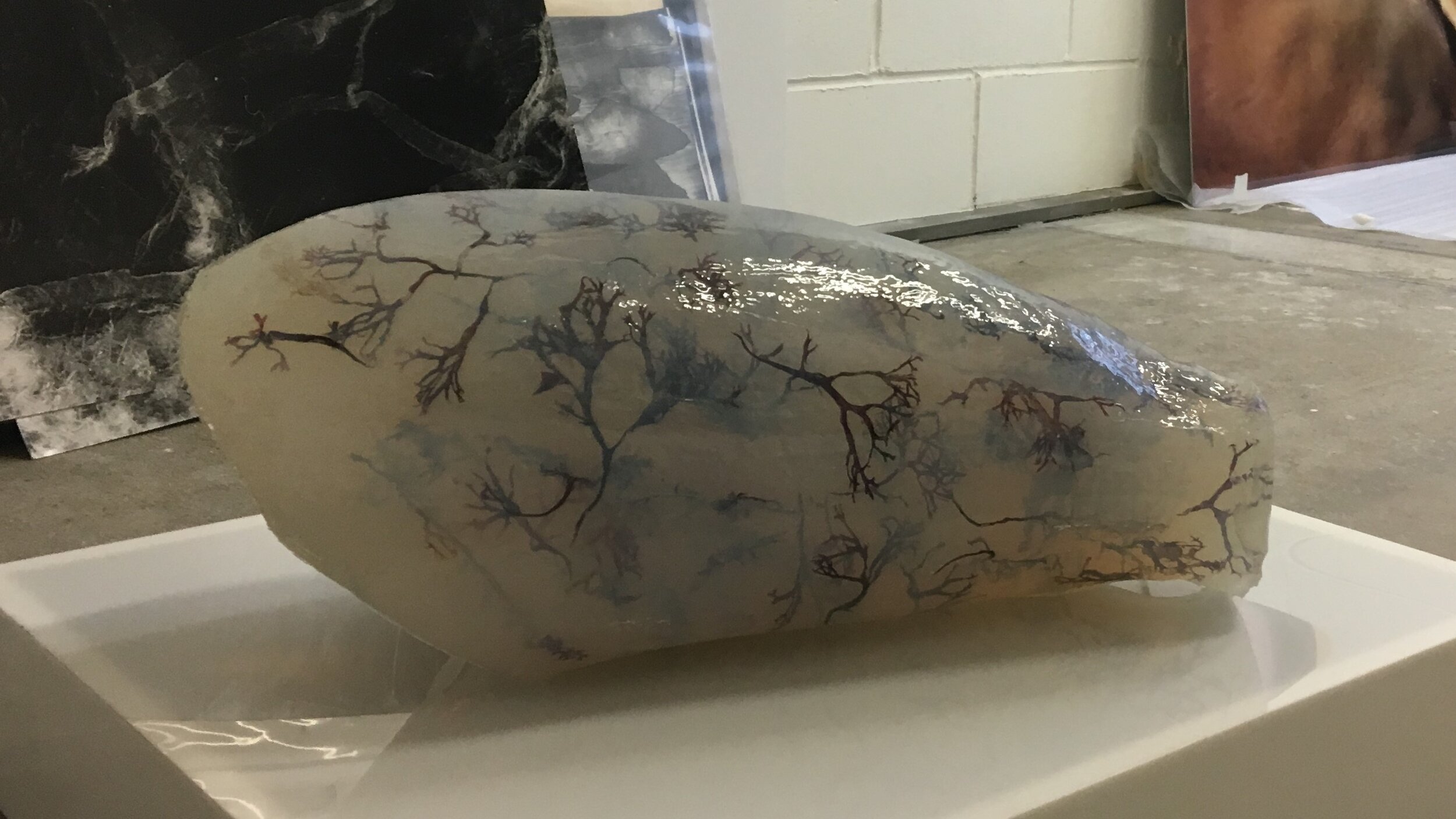Bethany Marett

Bethany picked me up from the Gallions Reach station and we walked back to her amazing studio, located at the Royal Albert Wharf. The studio is part of the Almacantar studio programme, and Bethany one of three recipients of this award to get a studio space for a year after her recent graduation from the Royal College of Art with an MA in Print.
The very first thing I noticed when I entered her studio is also one of the things that drew me to her work when I first saw it online. It’s a silicone cast, ‘nerved’ with red-blueish ‘veins’ that are not easily identified as algae on the first glance. Bethany’s work forces itself on you because you cannot help but be fascinated with what you’re looking at - even though it takes a while to figure out what exactly it is. A milky, conic silicone form, pervaded with red algae only slowly reveals itself a cast of a thigh. Bethany’s thigh to be exact (though I doubt that the work will reveal that detail to anyone, no matter how long you engage with the work). She tells me how growing up in Northern England, she was confronted with a lot of criticism and shame about her body: thighs are not supposed to be this big.
To this day, she tells me, she has gotten comments about the cast - ‘that’s your thigh?! It’s huge’ - mostly from women. But what opened her perspective was a tutorial with the artist Faisal Abdu’Allah reminding her about how in the Caribbean, women with big thighs are desirable. How big thighs symbolize power. This is an important message in Bethany’s work: there is more than one point of view, more than one narrative.
We talk about her choice to get a degree in print, and before I visited Bethany in her studio I had a narrow idea about what printmaking has to be, what it has to do. But I’ve learned about all the possibilities of it from that one studio visit. Casting parts of her body, Bethany says, is like making a print of it. It’s the three dimensional expansion of what a two-dimensional print can be. To emphasise this Bethany hands me a heavy-weight bronze titled ‘Perpetual Rolls.’ (side note: is it just me or does anyone else experience the phenomenon that bronze is: you look at it and know it’s heavy, but are still caught off guard by exactly how heavy?!) This heavy work with sharp, solid lines is the negative space of her tummy folds. Once again, Bethany uses her own body in a powerful and unexpected way to comment on beauty standards, the so-called ideal and its reality. The bronze immediately joins the canon of art history and what we know and expect of a bronze, but simultaneously refuses to be a part of it. I can see the marks the small hairs on her belly left on the cast and the dents and folds her body naturally shows when pushed into a seated position.
Her newest work, which she cast in a sped-up process just for our visit, sits like a shark’s fin on the floor. Knowing her process a bit better by now, I try to think where on her body I can find this form. Nothing comes to mind. And that is where Bethany’s work keeps on surprising and amazing: this is not a cast of something that is there - not really. It’s the visualisation of what has become a social construct through the media: her thigh gap. The shark’s fin is sharp, and thin. It’s because she doesn’t have a thigh gap, Bethany jokes. Yet here’s a massive, monumental, heavy cast to prove otherwise by materialising the negative space around her body.
Another, older, work suggests a hilly landscape cast in blue and white glass with a lake of perfumed liquid in its centre. I am so in love with these small table top sculptures that for a moment I forget that they cannot not be what they seem. They are lovely, but they are much more profound. A cast of her collarbone. A subtle but strong commentary on the perception and demands on a woman’s body and female rituals. Bethany talks about ‘moist’ and ‘wetness’ - sexualized words in connection with the female body - and about how even in contemporary medical language the female body is presented as more of a taboo than the male.
Some of the works on her wall then take it from ambiguous to straight out uncomfortable. Again, I am need to spend time with the works to even come close to understanding what it is that I am looking at (but maybe it’s not the point of to figure it all out, now is it?!). A cast of her breast, turned inside out and photographed. The final product is a C-Type print of an imprint of light of the inside of an imprint of her body. Was I promising too much about the possibilities of print?!
I can’t help but talk about the performance of her body as the form for her works but also the performance of her body when making these multi-layered works. The almost ritualistic sequences that lead her to the final product. All of her work feels bodily, and most importantly it feels familiar, but it’s subtle and cannot be read or understood with just one glance. I could spend hours with her work and find new things to learn about it, but in a wonderful way also learn more about myself, my body and my relationship to it. You need to spend time with the work, ‘you have to be with it’.
Thank you, Bethany, for letting us into your studio and teaching us a bit more about acceptance, the body and the pertinence of contemporary printmaking.
Bethany in her studio at Royal Albert Wharf, London
Lynn visited Bethany at her studio in Royal Albert Wharf, London on 2 December 2018.









